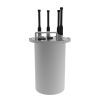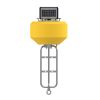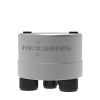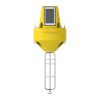NexSens NX260 Turbidity Sensor
Features
- Integrated wiper to reduce biofouling and extend deployment times
- Corrosion-resistant titanium housing with marine-rated connector
- Smart sensor supports multi-point calibrations via graphical user interface
- Expedited repair and warranty service
- Lifetime technical support
- More
The NexSens NX260 Turbidity Sensor is an optical, self-cleaning sensor designed to measure turbidity in lakes, rivers, bays, and other freshwater or marine environments. The probe is ideal for construction sites, dredging projects, stormwater applications, and many other water quality monitoring settings where water clarity is a concern.
The sensor emits light that scatters off suspended particles in the water, and the reflected intensity is measured by a photodetector at 90 degrees. An internal microprocessor applies calibration coefficients and outputs turbidity measurements in FNU. The integrated wiper cleans the optical lens prior to each measurement, ensuring accurate readings and reducing maintenance requirements.
The sensor is housed in a corrosion-resistant titanium body with marine-rated connector and scratch-resistant sapphire lens. No wiring or programming is required to integrate the sensor with NexSens X-Series data loggers. Connection to other data loggers is available using RS-485 Modbus-RTU protocol or SDI-12 with an optional converter. NexSens CONNECT software is used for configuration, calibration, and sensor verification.
Sensor: Optical, 90° scatter
Units of Measure: FNU
Range: 0-1000 FNU
Accuracy: ±5% or 0.3 FNU (whichever is greater)
Display Resolution: 0.01 FNU
Response Time: 15 seconds
Refresh Rate: 2 seconds
Wiper: On power up and on command (10 second wipe cycle)
Construction: Titanium body & connector
Operating Temperature: 0-50°C
Maximum Depth: 100 ft. (30m)
Communications: RS-485 Modbus RTU, SDI-12 (with optional adapter)
Power Requirement: 12-24 VDC
Current Draw: <100mA
Connector: MCBH-6-MP
Dimensions: 1.42” (36mm) diameter x 8.03” (203.96mm) length
Weight: 12.7 oz (360g)
Warranty: 1-year
In The News
From Paddles to Phytoplankton: Studying Vermont’s Wildest Lakes
For six months of the year, Rachel Cray, a third-year PhD student at the Vermont Limnology Laboratory at the University of Vermont, lives between a microscope and her laptop, running data. For the other six months, she is hiking and canoeing four of Vermont’s lakes, collecting bi-weekly water samples. Cray studies algal phenology across four lakes in Vermont, US, that have low anthropogenic stress—or in other words, are very remote. Funded by the National Science Foundation Career Award to Dr. Mindy Morales, the lakes Cray researches part of the Vermont Sentinel Lakes Program, which studies 13 lakes in the area and, in turn, feeds into the Regional Monitoring Network, which operates in the Northeast and Midwest US.
Read MoreReimagining Water Filtration: How Monitoring and Science Enhance FloWater Filtration Systems
Over 50% of Americans think their tap water is unsafe , according to the Environmental Working Group (EWG). Other recent surveys have found that number to be as high as 70% of persons surveyed. Whether due to increased public awareness of water quality issues or confusion about how municipal water sources are regulated, there is a clear distrust of tap water in the United States. According to industry expert Rich Razgaitis, CEO and co-founder of the water purification company FloWater, this issue creates a damaging cycle. Razgaitis explained that the health and environmental problems associated with contaminated water aren’t the only issues. As people become increasingly aware that some tap water is unsafe, they resort to bottled water.
Read MoreMonitoring New Hampshire’s Aquatic Ecosystems: Continuous Data Collection in the Lamprey River Watershed
New Hampshire’s aquatic ecosystems provide a range of ecosystem services to the state and region. Resources and services like clean water, carbon storage, climate regulation, nutrient regulation, and opportunities for recreation all depend on New Hampshire’s aquatic ecosystems remaining healthy. Jody Potter, an analytical instrumentation scientist at the University of New Hampshire (UNH), is studying these aquatic ecosystems in hopes of developing an improved understanding of ecosystem services and their interactions with climate change, climate variability, and land use changes. [caption id="attachment_39799" align="alignnone" width="940"] Aquatic sensors in the Merrimack River in Bedford, NH, with I-293 in the background.
Read More




















